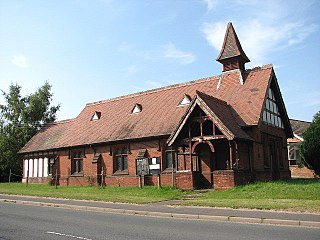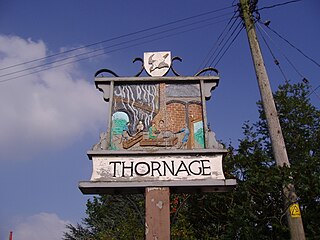
Sir Edwin Landseer Lutyens was an English architect known for imaginatively adapting traditional architectural styles to the requirements of his era. He designed many English country houses, war memorials and public buildings. In his biography, the writer Christopher Hussey wrote, "In his lifetime (Lutyens) was widely held to be our greatest architect since Wren if not, as many maintained, his superior". The architectural historian Gavin Stamp described him as "surely the greatest British architect of the twentieth century".

Cromer is a coastal town and civil parish on the north coast of the English county of Norfolk. It is 23 miles north of Norwich, 116 miles north-northeast of London and four miles east of Sheringham on the North Sea coastline. The local government authorities are North Norfolk District Council, whose headquarters is on Holt Road in the town, and Norfolk County Council, based in Norwich. The civil parish has an area of 4.66 km2 and at the 2011 census had a population of 7,683.

Overstrand is a village on the north coast of Norfolk in England, two miles east of Cromer. It was once a modest fishing station, with all or part of the fishing station being known as Beck Hythe. In the latter part of the 19th century it was catapulted into prominence, and became known as “the village of millionaires”.

Stowmarket railway station is a stop on the Great Eastern Main Line (GEML) in the East of England, serving the market town of Stowmarket, Suffolk. The station is 80 miles 9 chains (128.9 km) down the line from London Liverpool Street; it is situated between Needham Market to the south and Diss to the north. It is also the junction where the Ipswich to Ely Line joins the GEML. Its three-letter station code is SMK. The station is operated by Greater Anglia, which also runs all trains that serve the station.

Hanworth is a village and a civil parish in the English county of Norfolk. It is 18.8 miles (30.3 km) north of Norwich, 5.4 miles (8.7 km) south-west of Cromer and 133 miles (214 km) north-east of London. The nearest railway station is Gunton on a branch line, the Bittern Line, commencing at Norwich. Norwich International Airport is closer to the city. The parish had in 2001 and 2011 a population of 169 people. The primary local government authorities are North Norfolk and for education, social care and much infrastructure Norfolk County Council.

Swanton Morley is a village and civil parish situated in the English county of Norfolk. It is situated in the heart of Norfolk 18 miles from the centre of Norwich and three miles from Dereham, at the geographical centre of Norfolk. It covers an area of 11.14 km2 (4.30 sq mi) and had a population of 2,415 in 783 households at the 2001 census, reducing to a population of 2,100 in 723 households at the 2011 Census. For the purposes of local government it is in the Elmham and Mattishall Division of Norfolk County Council and the Lincoln Ward of Breckland District Council.

Abbas Hall is a small country house in Great Cornard, a village located near the town of Sudbury, Suffolk in England, the Elizabethan exterior of which masks a medieval two-bay aisled hall of c.1290, from which two massive oak posts with moulded capitals and two arches of the screens passage survive. The inserted floor in the great hall was put in about 1548–49. The house was originally the house of West Malling Abbey's manorial steward here. The house, from the grounds of which Thomas Gainsborough painted his celebrated view of Great Cornard Wood, was restored by the present owner, Stefan Kosciuszko, Chief of Staff Hinduja Group, and chief executive AMAS-IPS, the project development company for the Group, after 1995.

A Butterfly plan, also known as a Double Suntrap plan, is a type of architectural plan in which two or more wings of a house are constructed at an angle to the core, usually at approximately 45 degrees to the wall of the core building. It was used primarily in late Victorian architecture and during the early Arts and Crafts movement.

Goddards is a Grade II*-listed house in Abinger Common, Surrey, England, completed in 1900. It was designed by Edwin Lutyens in the ideals of the Arts and Crafts movement and the west-facing courtyard garden was designed by Gertrude Jekyll. The house uses local building materials, including Horsham stone tiles, and the two wings are spayed at an angle towards the late-afternoon sun. The design is influenced by vernacular hall houses and almshouses, as well as the architectural ideas of the late-19th century and the Tudor period.

Honing is a village and a civil parish in the English county of Norfolk. It is located 15 miles (24 km) north-north-east of Norwich, 13 miles (21 km) south-east of Cromer and 4 miles (6.4 km) east of North Walsham. The parish of Honing, which includes Crostwight, had a population of 319 in the 2001 census, but this fell to 312 at the 2011 Census. The village is part of the district of North Norfolk.

Lenwade is a village in the civil parish of Great Witchingham, Norfolk, situated in the Wensum Valley adjacent to the A1067 road 14 miles (23 km) south-east of Fakenham and some 11 miles (18 km) north-west of Norwich. The River Ainse joins the Wensum at Lenwade. In 2001 it had a population of 464.

Thornage is a village and a civil parish in the English county of Norfolk. The village is 2.7 miles south-west of Holt, 23.2 miles north-west of Norwich and 11.3 miles east of Fakenham, and straddles the B1110 road between Holt and Guist. The nearest railway station is at Sheringham for the Bittern Line which runs between Sheringham, Cromer and Norwich. The nearest airport is at Norwich International Airport.

Charles William Mills, 2nd Baron Hillingdon was a British banker and Conservative politician who sat in the House of Commons from 1885 to 1892, speaking once, in 1889.

Thurning is a small dispersed village and civil parish in the English county of Norfolk and district of North Norfolk, near the border with Broadland. The population at the 2011 Census remained less than 100 and is recorded together with the neighbouring civil parish of Hindolveston.
Shropham Hall is an early Georgian country house in Shropham in the county of Norfolk. It was completed by 1729 for John Barker, later High Sheriff of Norfolk. It was later the home of Sir Edward Grogan, 2nd Baronet. The hall is listed Grade II on the National Heritage List for England.

Ellingham Hall, Norfolk

The Sea Marge Hotel is an AA 4-star hotel in the English seaside village of Overstrand in the county of Norfolk. The hotel also has 2 AA Rosettes for Food.
John Bond Pearce was an English architect from Norwich, Norfolk. His architectural practice was in Surrey Street, Norwich. His son Neville Bond Pearce was also a noted architect. Pearce designed many of his building in the Victorian Gothic architectural style, a good example being the town hall in Great Yarmouth opened in 1882.

Mannington Hall is a moated medieval country house in the civil parish of Itteringham near the village of the same name and is in the English county of Norfolk within the United Kingdom. The first manor house built on this site was constructed in the 15th century. Having been owned by the Walpole family since the 18th century, it is now the seat of Jonathan Walpole, 11th Baron Walpole.

Hemblington Hall is a large farmhouse in Norfolk county, England, built around 1700 with a Georgian facade. This grade II listed building was the home of the Heath family during the 18th and 19th centuries. The nearby All Saints Church contains memorials to many members of the Heath family. By the 19th century Hemblington Hall was part of the Burlingham Hall Estate owned by the Burroughes family until it was sold off in 1919.




















